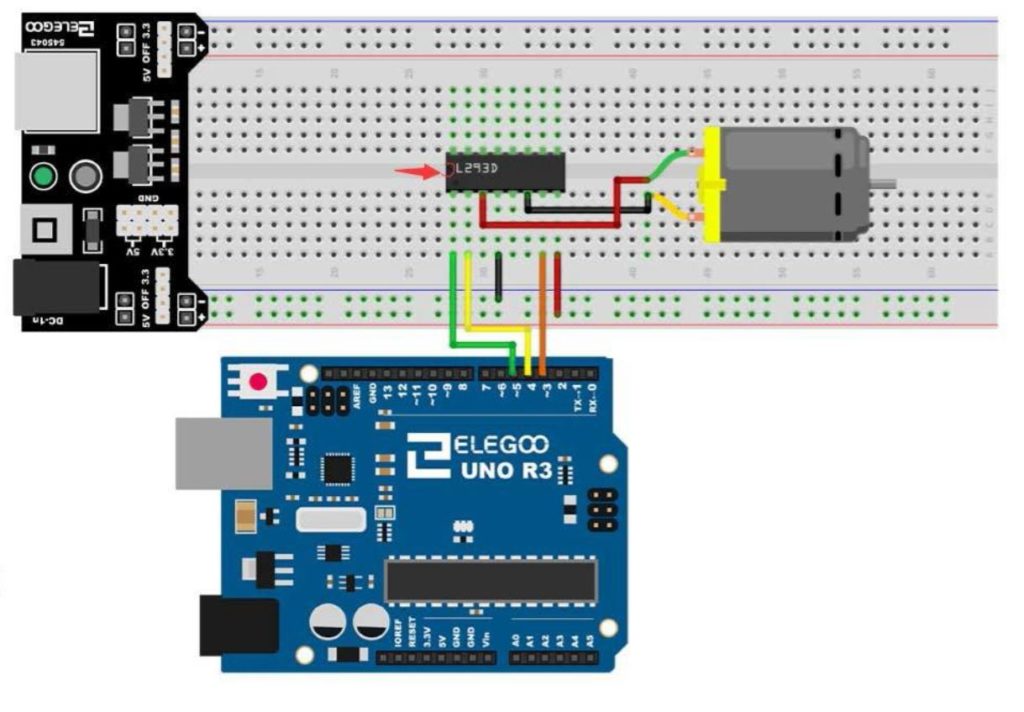To play along at home, you will need an Arduino Nano, and an Adafruit BNO055 Inertial Measurement Sensor. In this lesson we create a live visual where a 3D model rotates in space mimicking the pitch and yaw of the breadboard in the real world. We have not yet derived and implemented the math to incorporate roll into the simulation but that will ab done in the next lesson.
This is the code on the arduino side we developed in the video:
1 2 3 4 5 6 7 8 9 10 11 12 13 14 15 16 17 18 19 20 21 22 23 24 25 26 27 28 29 30 31 32 33 34 35 36 37 38 39 40 41 42 43 44 45 46 47 48 49 50 51 52 53 54 55 56 57 58 59 60 61 62 63 64 65 66 67 68 69 70 71 72 73 74 75 76 77 78 79 80 81 82 83 84 85 86 87 88 89 90 91 92 93 94 95 96 97 98 99 100 101 102 103 104 105 106 107 108 | #include <Wire.h> #include <Adafruit_Sensor.h> #include <Adafruit_BNO055.h> #include <utility/imumaths.h> #include <math.h> float thetaM; float phiM; float thetaFold=0; float thetaFnew; float phiFold=0; float phiFnew; float thetaG=0; float phiG=0; float theta; float phi; float thetaRad; float phiRad; float Xm; float Ym; float psi; float dt; unsigned long millisOld; #define BNO055_SAMPLERATE_DELAY_MS (100) Adafruit_BNO055 myIMU = Adafruit_BNO055(); void setup() { // put your setup code here, to run once: Serial.begin(115200); myIMU.begin(); delay(1000); int8_t temp=myIMU.getTemp(); myIMU.setExtCrystalUse(true); millisOld=millis(); } void loop() { // put your main code here, to run repeatedly: uint8_t system, gyro, accel, mg = 0; myIMU.getCalibration(&system, &gyro, &accel, &mg); imu::Vector<3> acc =myIMU.getVector(Adafruit_BNO055::VECTOR_ACCELEROMETER); imu::Vector<3> gyr =myIMU.getVector(Adafruit_BNO055::VECTOR_GYROSCOPE); imu::Vector<3> mag =myIMU.getVector(Adafruit_BNO055::VECTOR_MAGNETOMETER); thetaM=-atan2(acc.x()/9.8,acc.z()/9.8)/2/3.141592654*360; phiM=-atan2(acc.y()/9.8,acc.z()/9.8)/2/3.141592654*360; phiFnew=.95*phiFold+.05*phiM; thetaFnew=.95*thetaFold+.05*thetaM; dt=(millis()-millisOld)/1000.; millisOld=millis(); theta=(theta+gyr.y()*dt)*.95+thetaM*.05; phi=(phi-gyr.x()*dt)*.95+ phiM*.05; thetaG=thetaG+gyr.y()*dt; phiG=phiG-gyr.x()*dt; phiRad=phi/360*(2*3.14); thetaRad=theta/360*(2*3.14); Xm=mag.x()*cos(thetaRad)-mag.y()*sin(phiRad)*sin(thetaRad)+mag.z()*cos(phiRad)*sin(thetaRad); Ym=mag.y()*cos(phiRad)+mag.z()*sin(phiRad); psi=atan2(Ym,Xm)/(2*3.14)*360; Serial.print(acc.x()/9.8); Serial.print(","); Serial.print(acc.y()/9.8); Serial.print(","); Serial.print(acc.z()/9.8); Serial.print(","); Serial.print(accel); Serial.print(","); Serial.print(gyro); Serial.print(","); Serial.print(mg); Serial.print(","); Serial.print(system); Serial.print(","); Serial.print(thetaM); Serial.print(","); Serial.print(phiM); Serial.print(","); Serial.print(thetaFnew); Serial.print(","); Serial.print(phiFnew); Serial.print(","); Serial.print(thetaG); Serial.print(","); Serial.print(phiG); Serial.print(","); Serial.print(theta); Serial.print(","); Serial.print(phi); Serial.print(","); Serial.println(psi); phiFold=phiFnew; thetaFold=thetaFnew; delay(BNO055_SAMPLERATE_DELAY_MS); } |
This is the code on the Python side we developed in the video:
1 2 3 4 5 6 7 8 9 10 11 12 13 14 15 16 17 18 19 20 21 22 23 24 25 26 27 28 29 30 31 32 33 34 35 36 37 38 39 40 41 42 43 44 45 46 47 48 49 50 51 52 53 | from vpython import * from time import * import numpy as np import math import serial ad=serial.Serial('com5',115200) sleep(1) scene.range=5 toRad=2*np.pi/360 toDeg=1/toRad scene.forward=vector(-1,-1,-1) scene.width=600 scene.height=600 xarrow=arrow(lenght=2, shaftwidth=.1, color=color.red,axis=vector(1,0,0)) yarrow=arrow(lenght=2, shaftwidth=.1, color=color.green,axis=vector(0,1,0)) zarrow=arrow(lenght=4, shaftwidth=.1, color=color.blue,axis=vector(0,0,1)) frontArrow=arrow(length=4,shaftwidth=.1,color=color.purple,axis=vector(1,0,0)) upArrow=arrow(length=1,shaftwidth=.1,color=color.magenta,axis=vector(0,1,0)) sideArrow=arrow(length=2,shaftwidth=.1,color=color.orange,axis=vector(0,0,1)) bBoard=box(length=6,width=2,height=.2,opacity=.8,pos=vector(0,0,0,)) bn=box(length=1,width=.75,height=.1, pos=vector(-.5,.1+.05,0),color=color.blue) nano=box(lenght=1.75,width=.6,height=.1,pos=vector(-2,.1+.05,0),color=color.green) myObj=compound([bBoard,bn,nano]) while (True): while (ad.inWaiting()==0): pass dataPacket=ad.readline() dataPacket=str(dataPacket,'utf-8') splitPacket=dataPacket.split(",") roll=float(splitPacket[0])*toRad pitch=float(splitPacket[1])*toRad yaw=float(splitPacket[2])*toRad+np.pi print("Roll=",roll*toDeg," Pitch=",pitch*toDeg,"Yaw=",yaw*toDeg) rate(50) k=vector(cos(yaw)*cos(pitch), sin(pitch),sin(yaw)*cos(pitch)) y=vector(0,1,0) s=cross(k,y) v=cross(s,k) frontArrow.axis=k sideArrow.axis=s upArrow.axis=v myObj.axis=k myObj.up=v sideArrow.length=2 frontArrow.length=4 upArrow.length=1 |

